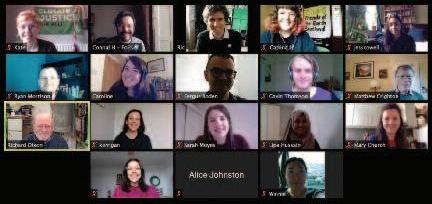
9 minute read
Campaign updates
Dr Richard Dixon, Director @Richard _ Dixon
The FoES team working from home.
Advertisement
One year to go.
By the time you read this we will be coming to the end of our Just and Green Recovery Week of Action and an online Global Gathering of talks, workshops and strategy session on climate change will be well underway. The delay of the UK Budget and resulting uncertainty about the scale of the Scottish Budget for next year has meant it has been hard to talk to the Scottish Government about making sure the recovery from COVID-19 is both just and green. The Week of Action has involved working with many of the groups who sent a letter to Nicola Sturgeon in May, and saw hundreds of people from across the country telling politicians of the need to create a better Scotland as we emerge from the pandemic. Mid-November marks the mid-point of the UN climate talks in Glasgow, if they had gone ahead as planned. Now postponed until late 2021, this means the world’s governments have escaped the global scrutiny these annual talks always bring. We are already central to what will happen around these talks, having helped create the coalition of civil society groups that is working together across the UK, and we host the Scottish coalition co-ordinator Quan who you’ll hear from inside this issue. We’ll be helping organise whatever mass demonstration can take place and also looking after the international Friends of the Earth delegates who come to the conference – COVID-19 permitting –to speak up on behalf of people and nature around the world. With this issue of What on Earth you will find an appeal asking you to help us work, over the next year, to make sure that politicians cannot forget about climate change, and activists and campaigners are well prepared to make the most of the global talks coming to Glasgow.
For a Recovery that works for people and planet
By Caroline Rance, Climate and Energy Campaigner

It’s now been eight months since the UK went into lockdown. Few of us knew back then that restrictions would last so long or reach into so many corners of our lives. While this is an incredibly difficult time for many of us, across Scotland people are uniting to dream of, and demand, a better future where we put people and planet first.
The campaign for a Just and Green Recovery for Scotland has been busy connecting people up and down the country to share their priorities for building back better. Together with a coalition of over 80 other charities, grassroots groups, churches and trade unions, we’ve met Government Ministers and MSPs, supported health workers and climate strikers to take their message to Government headquarters in Edinburgh, and held online rallies, webinars and workshops. As this lands through your letterbox, hundreds of people have taken part in a Week of Action, meeting their MSPs online.
Kickstart a Green Jobs Recovery
The UK is now in the deepest recession since records began. Tens of thousands of people have already lost their jobs in Scotland, with unemployment higher here than across the rest of the UK and expected to rise further now that the furlough scheme has come to an end. Meanwhile, a year has passed since the Scottish Parliament passed our new climate targets and there has been no new action to cut emissions.
That’s why we’ve been calling on the Scottish Government to kickstart a programme of green job creation. Our plan for a green jobs recovery would see thousands of new jobs, all working in areas that would help cut Scotland’s climate emissions with investment in national green infrastructure projects, including in energy efficiency, sustainable transport and renewable heating. We’re also supporting trade unions fighting for workers facing redundancies in Scotland’s existing green industries, including electric bus manufacturer Alexander Dennis and wind turbine company CS Wind. These are exactly the kind of jobs we need to support and grow for the future.
Turning government promises into action
The Scottish Government has talked about building a green recovery and a wellbeing economy, but so far we haven’t seen the plans to make it a reality. If they’re serious about building back to a fairer, greener Scotland we urgently need to see those promises turned into action.
In September, the First Minister announced £1.6 billion to be spent on heat and energy efficiency over the next five years. It is a welcome long-term commitment, but the money wouldn’t actually begin for a year. To kickstart the recovery and create much needed jobs, the Government has to start spending now.
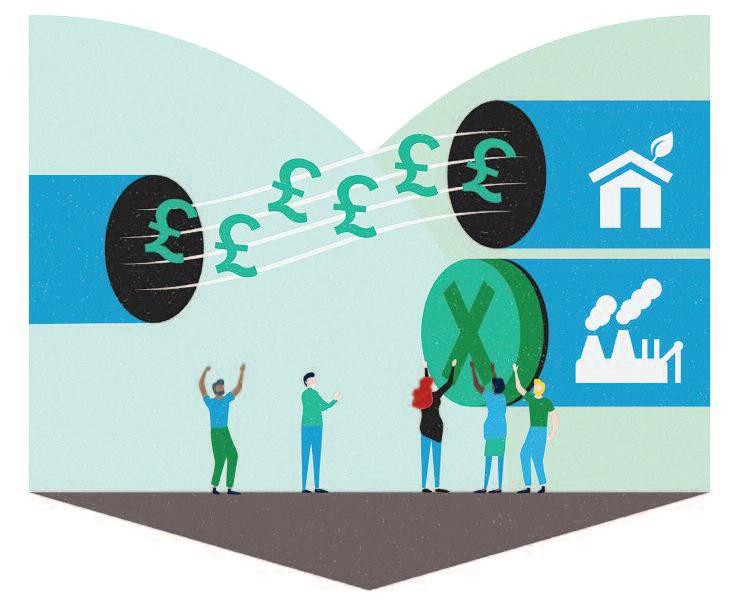
In the coming weeks, the Government will be writing and publishing Scotland’s spending plans. The Budget must include new investment for making our homes warmer and more energy efficient, and powering our transport and heating systems with renewable energy.
A thorough review of spending could redirect investment away from high carbon polluting projects, such as road building into improving broadband connections. Crucially, there must be no more public money for new fossil fuel projects, including the false solutions of Carbon Capture and Storage, and fossil fuel-derived Hydrogen.
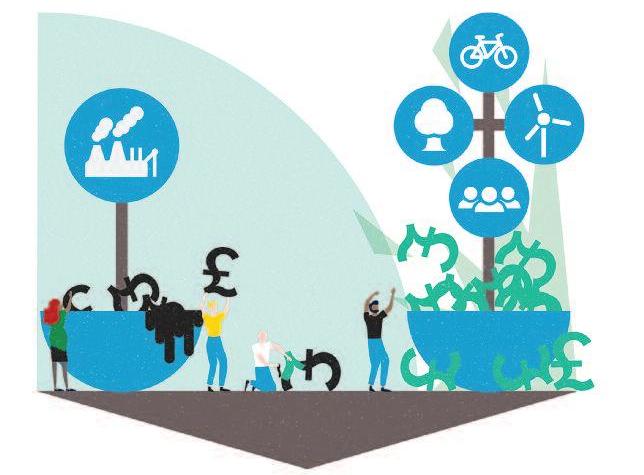
When public pressure successfully forced the Scottish Government to set higher targets for climate action last year, it meant they then had to come up with a plan to achieve these targets.
The Climate Change Plan is that roadmap for cutting emissions and meeting our climate targets between now and 2032. The plan was supposed to arrive in April but suffered a delay due to COVID-19 and is now scheduled for December 2020.
What’s in the Plan?
The plan should look at where we are now in terms of climate emissions from each sector of Scottish life and where we need to get to. It lays out the progress that has been made so far and should set out the actions that will be taken in reducing emissions from that area.
Given that Scotland missed its targets for cutting emissions last year and is hosting the UN Climate Conference in 2021, it is incredibly
What is Scotland’s Climate Change Plan?
By Jess Cowell, Climate Campaigner
important that the plan commits to urgent action that gets us back on track. The Scottish Government likes to laud its targets but they must be backed up with stronger policies and real action to meet them.
What should it do?
The Plan must address sectors where there has been very little progress to date especially in transport, buildings and waste. In transport for example, emissions have only dropped about 5% in a 30 year period. We need to see stronger action to make sure projects which worsen climate change like major road building are no longer the priority.
Instead, we should be supporting walking, cycling and accessible public transport with a move towards significantly increased bus travel. This would deliver wider public benefits such as increased ability to travel safely, cheaper and with less air pollution.
The buildings sector also presents a big opportunity as there has only been slow progress so far in reducing emissions from how we heat our homes. We need to see the Government mapping out how it will increase renewable energy, heat networks, ground source heat pumps and insulate people’s homes. This would keep homes warmer whilst reducing bills and help the 600,000 people living in fuel poverty.
We also need to see a Just Transition taken seriously in this plan. It is crucial that the Government outline how it plans to support the managed phase out of high polluting activities into zero carbon ones that continue to support workers and communities. For example, in transport, the move from fossil fuel powered buses to electric ones should be supported with investment, with the Government spelling out the cost of this change and how many Scottish jobs will be provided in this industry. The updates must also not rely on negative emission technologies such as Carbon Capture and Storage or Bio-Energy Carbon Capture and Storage. These technologies cannot reduce emissions at the scale required and are being used as cover by the fossil fuel industry to keep digging and burning gas. In the Plan we need to see real and proven solutions like putting an end date on fossil fuel infrastructure and investing in wide-scale renewable energy and electrification.
Public pressure won these higher targets so now we need to make sure that the Government has produced a credible plan for achieving them. With your help, we'll be pushing MSPs from all parties into supporting more action and keeping the pressure on the Scottish Government to deliver on its climate promises.
Photo: Brett and Sue Coulstock / Flickr (CC BY 2.0)


Pollution delays threaten our health
By Gavin Thomson, Air Pollution Campaigner
In the early months of the pandemic, as people stayed at home and cars disappeared off the roads, our air quality improved substantially. However, it was only temporary with the traffic – and pollution – soon returning. To make matters worse, the Scottish Government announced in August that a measure to improve our air in more sustainable way would be delayed.
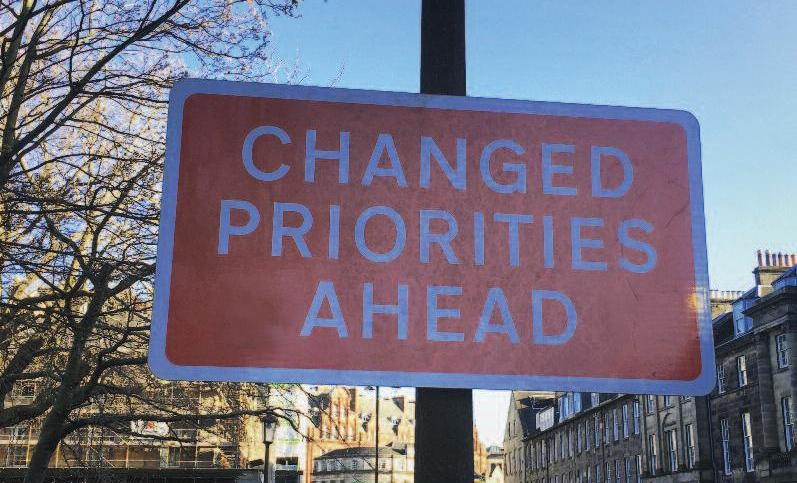

Low Emission Zones, due to begin this year, now won’t be started until 2022. A shocking delay. Air pollution makes people more vulnerable to Covid-19, with traffic emissions causing and exacerbating many of the heart and lung conditions that put people at heightened risk from the virus. The pandemic should have shown us the need to act now on air quality and protect public health.
Transport is our most polluting sector in terms of climate emissions, so this delay to LEZs also makes it harder for us to meet climate targets at national and local levels. Many of these targets are carbon reductions by 2030. This is very soon in transport terms – families and businesses will probably only make one big consumer decision like purchasing a vehicle between now and then. Stronger regulations need to be introduced now so that everyone has plenty of time to adapt.
Edinburgh bike hire scheme.Photo: Anna Kalota

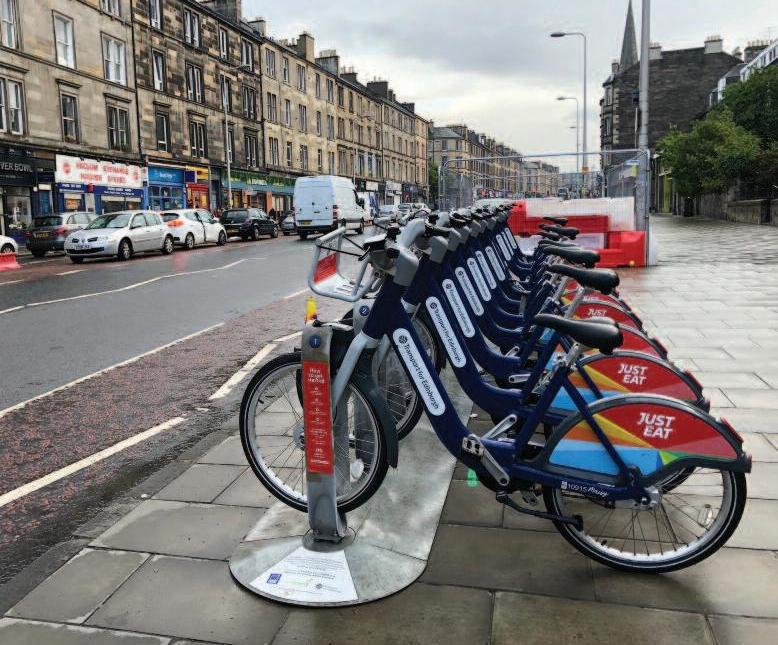
Glasgow’s Zone was introduced at the end of 2018, but it will only restrict polluting buses for the next couple of years. Edinburgh’s Zone, which only restricts the most polluting cars from a tiny area in the Old Town, was agreed last year by the Council. Aberdeen City Council just finished a consultation process on the size of their zone
According to the legislation, anywhere with persistent air pollution problems by 2023 will need to introduce a Zone. This needn’t be a big city; this could be anywhere where people are exposed to emissions from heavy traffic. Many of us have been cycling much more in 2020, which is great for our health and reducing emissions. But public transport has taken a big hit, financially and reputationally. Looking ahead to the 2021 elections, and the coming decade, every political party will need to be thinking of game changing transport measures if they have any interest in meeting climate change targets. Kicking the can further isn’t an option; we’ve run out of road.





